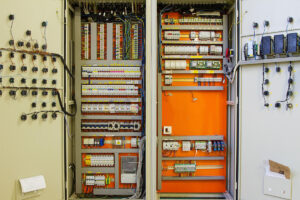Technology is making a huge impact on the construction industry as well as its trade industries like electrical contracting. In this field, numerous innovative tech tools have been introduced but there are also new discoveries that are worth mentioning. All these modifications are changing the way electrical construction works, as well as how electricity is created. Overall, they promote higher efficiency both during the construction process and the turnover of buildings.
Today, we’re going to look into how technology is improving an electrical subcontractor’s construction crew management, project handling, submittals, and safety strategies. We’ll also discuss some new amazing discoveries in energy generation that can be used by electrical system designers in building new sustainable construction projects.
New Discoveries in the Electrical Field
- Smart Grid
The Smart Grid is simply a revolution to the traditional grid. Basically, it has made communication between the electric provider and the customer smarter by using sensors and smart meters connected to smart appliances at home and the offices. It has made readings digital, making it easier and faster for the power company to provide the right power flow needed.
So to make living in a building more convenient, electrical subcontractors can consider using this new grid in their electrical system design.
- Na-TECC
The Georgia Tech’s George W. Woodruff School of Mechanical Engineering is experimenting on a conversion energy engine using sodium’s isothermal and solar heat for generating electricity. This new engine was called “Na-TECC” ( Na-sodium and “Thermo-Electro-Chemical Converter”).
Basically, this machine improves energy efficiency so that lesser heat will leak. That means more savings on electricity. The experiments involved using solar power to run the machine and power a whole house. Soon, when it’s fully developed, it can already be recommended by electrical subcontractors for new building construction.
The experiment is still ongoing and is funded by the Department of Energy’s (DOE) SunShot Program.
- The Revolution of Betavoltaics
In another, the same school in Georgia is recycling nuclear waste to produce electricity. Only this time, the engine isn’t using reactors and sans moving parts.
Experiments are being made on this new breed of betavoltaics, which is funded by the Defense Advanced Research Projects Agency (DARPA). The agency is collaborating with Stanford University’s team of researchers.
Overall, this betavoltaics can achieve conversion efficiencies of between 4 and 18 percent. That means high savings in electricity generation. They even revealed that this technology can generate about one watt of power continuously for as long as 30 years. Although this low power can’t be used in buildings, researchers believe that they ca soon perfect the new betavoltaics so they can produce more power that’s needed in bigger structures.
Technology Trends in the Electrical Construction Trades
After those savvy discoveries that can still be improved in the coming years, let’s now look into the current technologies that are shaping a stronger electrical trades industry. From AI to robotics to wearables and software, electrical subcontractors certainly have a lot of innovative tools they can use to minimize human error, make electrical work safer, and enhance electrical construction crew management.
- Robotics and Drones
Robots are being used these days to replace human labor to make work faster and more accurate. But in the electrical trades, robots are being deployed in places with high electrical hazards so as to prevent accidents and deaths.
Drones are also starting to be a huge part of the monitoring process of electrical subcontractors. These UAVs (Unmanned Aerial Vehicle) are used to take photos and videos of the site to give the project manager a clearer overview of the project even without visiting the site. This goes the same with electrical subcontractors who may need to handle one or two projects at the same time. Instead of using traditional mobile cameras or DSLRs to capture progress, crew members can use drones instead to capture images from hard-to-reach spots in the construction site.
- IoT and Cloud Computing
Data is also important for electrical subcontractors. The plan, schedule, drawing, budget, and other files they send to the site are vital to making the work of crew members efficient. Meanwhile, the reports that crew members write are a way for the electrical subcontractor to stay updated on what’s happening at the site. So should there be any issues, electrical workers can simply send the report via the cloud and the subcontractor receives it right away, enabling him to act on the issue immediately.
This is why we always recommend for subcontractors to shift to cloud-based software so that reporting and collaboration can be done in real-time.
- Smartwatch
While it seems like smartwatches are just luxuries for construction workers, but in the electrical trades, these gadgets are actually used for saving lives. The Proxxi Smartwatch, for instance, is a wearable that helps ensure the safety of electrical workers at the site by reducing risks of injuries and electrocution. The watch is equipped with sensors that notify the user of any high-voltage electricity sensed nearby. It also has GPS sensors that send out location stamps so that electrical subcontractors are sure that their workers are at the site where they are assigned.
- Smart Helmet and AR
Augmented Reality is quickly finding its rightful spot in the construction and electrical trades industries. DAQRI is one of the makers of smart helmets equipped with augmented reality glasses to assist electrical professionals in an optimized way. Like other industrial-grade AR glasses, DAQRI is equipped with cameras, sensors, and smart features that allow electrical workers to determine the exact location of ductwork and electrical cabling required in the building without having to look at the drawing repeatedly. Ultimately, it provides a hands-free means of reviewing documents while working at the site.
- BIM
BIM is a new way of creating models in the construction industry. It acts more than just a CAD where only the specs and dimensions are defined around the 2D sketch of the project. BIM, on the other hand, generates an intelligent 3D model that contains all the specs, standards, and physical functions of the parts of the project. This makes it easier for project teams to determine possible flaws in the original plan. This is also where other systems of the building are laid out like HVAC, ductworks, pipings, and electrical cables. This makes it easier for subcontractors to collaborate with each other as some systems are dependent on others like electrical cables and ductworks.
- Electrical Subcontractor Scheduling Software
To keep your electrical workers stay on top of their goals, you need to equip them with a digital tool that will serve as their reference for their tasks and deadlines. Paper documents are already obsolete and they were proven inefficient when it comes to relaying information. First, entries can be old and inaccurate on paper documents compared to the data used at the office. Changes can happen any time so it would be convenient to have a software where new files can be updated instantly. Second, a cloud-based electrical subcontractor scheduling software helps the subcontractor find out about issues in real-time and track progress regularly even without visiting the site. As you know, it can take over an hour or two to walk through buildings, making it time-consuming to check accomplishments every day. Accuracy, efficiency, and real-time collaboration and communication are the main offerings of electrical subcontractor scheduling software like Pro Crew Schedule.
- Prefabrication
The use of modular construction is becoming the new standard in the construction industry here in the U.S. as well as other parts of the world. This pre-engineered solution makes it faster to complete a project, but more than that, the established prefab manufacturers guarantee higher-quality construction components that comply with or even surpass the project’s specifications.
Some electrical systems can also be prefabricated in a manufacturing site where fittings are already attached to the pre-engineered components. Apart from prewired walls making work faster, prefabrication also makes the electrical workers safer.
- Energy-efficient Lighting
LED is still among the greatest innovation in the electrical field. The use of LEDs in buildings has greatly reduced energy consumption and they even produce better light quality than the traditional fluorescent bulbs. Furthermore, LEDs are longer-lasting and safer to use.
In the future, electrical experts believe that LEDs will become more prominent and they will be used in smart systems that are remote, heat, or voice-controlled. In fact, there are now houses and vehicles using LEDs that e connected with Alexa for more convenient control. Wireless LEDs are also expected to be developed in the coming yeas, making installation in buildings faster by up to 70 percent.
Conclusion
Technology will never cease to evolve so expect to see new tools in the electrical construction trades industry. Be sure to employ these technologies in your electrical subcontracting company as they will be useful in boosting the efficiency of your workers at the site as well as ensuring their safety.





